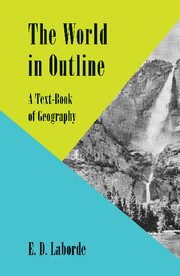Book contents
- Frontmatter
- Preface
- Contents
- PLATES
- PART I EUROPE
- PART II ASIA
- PART III AFRICA
- PART IV NORTH AMERICA
- PART V SOUTH AMERICA
- PART VI AUSTRALIA, NEW ZEALAND, AND THE PACIFIC ISLANDS
- Australia
- Human Geography
- New Zealand
- Human Geography
- The Pacific Islands
- Appendix: An Outline of Physical Geography
- Index of Place-Names
- General Index
Human Geography
from PART VI - AUSTRALIA, NEW ZEALAND, AND THE PACIFIC ISLANDS
Published online by Cambridge University Press: 05 June 2016
- Frontmatter
- Preface
- Contents
- PLATES
- PART I EUROPE
- PART II ASIA
- PART III AFRICA
- PART IV NORTH AMERICA
- PART V SOUTH AMERICA
- PART VI AUSTRALIA, NEW ZEALAND, AND THE PACIFIC ISLANDS
- Australia
- Human Geography
- New Zealand
- Human Geography
- The Pacific Islands
- Appendix: An Outline of Physical Geography
- Index of Place-Names
- General Index
Summary
Economic. Youth of settlement and poverty in minerals cause New Zealand to depend largely on grazing and agriculture. Five areas stand out as the most productive in the country, namely, the lower valleys of the Waikato and Thames, the east coast strip of the North Island from Featherston to Gisborne, the southwestern plain of the North Island; the Canterbury Plains, and the lowlands of Otago. The absence of drought makes New Zealand an excellent grazing country, and the chief source of wealth still lies in flocks and herds. In addition to the areas of natural grassland, wide stretches of what was once forest have been cleared and turned into pasture. Generally speaking, the wetter pasture lands of the Islands are used for cattle, while the drier east coast pastures are used for sheep.
Sheep farmers are constantly improving their ‘runs’ by planting soft, luscious English grasses instead of the hard native varieties, and so far they have brought about the change over rather more than half of the country. The product of the farms is either wool or mutton. Up to the economic changes of 1930, the value of the wool exported from New Zealand was far greater than that of the mutton, though the invention of cold storage methods has fostered the export of meat to the British Isles. A successful method of shipping ‘chilled’ mutton would give even greater stimulus to the trade.
The cattle farmer of New Zealand aims at exporting, not chilled beef, but dairy produce: butter, cheese, and condensed milk. As a rule, the cattle farm is smaller than the sheep farm and is owned by a less wealthy man. There are no areas exclusively for either sheep or cattle, but the latter are preferred in wet districts, and the number of animals is greater in the North Island than in the South Island. The dairying industry is highly organised on co-operative lines, with central factories which receive cream from the farms and turn it into butter, cheese, casein, and dried or condensed milk. Before export, the dairy produce undergoes a searching inspection intended to maintain the high standard of the guarantee implied by the government mark: ‘New Zealand Produce’. About four-fifths of the produce of the central factories are exported, mainly to Great Britain.
- Type
- Chapter
- Information
- The World in OutlineA Text-Book of Geography, pp. 479 - 487Publisher: Cambridge University PressPrint publication year: 2013



